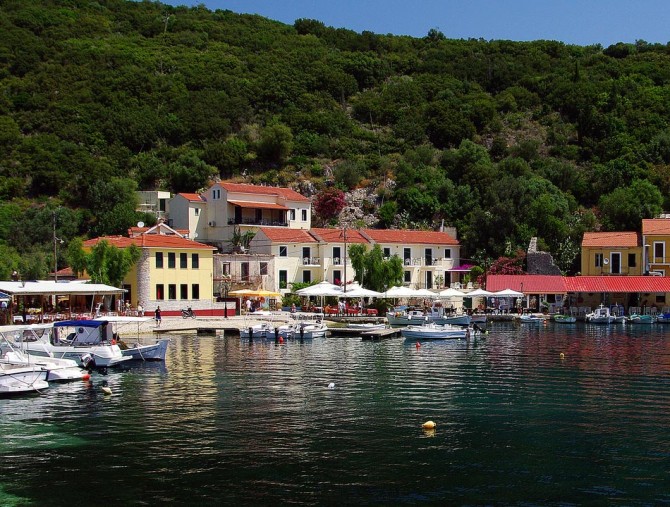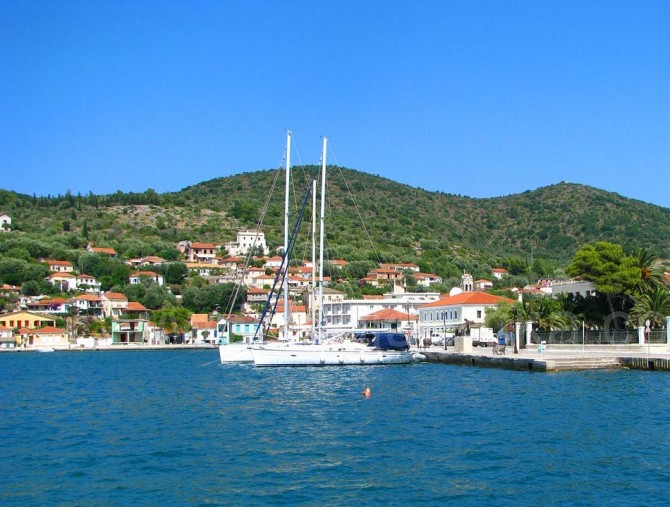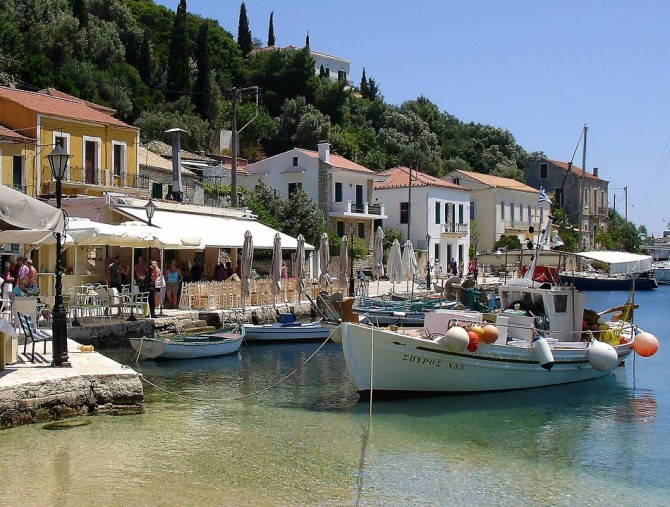Итака
В “Одиссее” Гомера Итака была родиной и царством Одиссея. Именно сюда он так хотел вернуться на протяжении десяти лет странствий.
Согласно мифологии, первым жителем острова был сын Посейдона и Амфиалии Итакос. Итака обитаема с конца III тыс. до н. э., однако, с археологической точки зрения, наиболее интересным представляется время, когда на острове царствовал Одиссей - XII век до н. э.. Впрочем, отождествление гомеровской Итаки с исторически существующей остаётся спорным.
В IX веке до н. э. начинается период подъёма для острова, который становится важным торговым пунктом. В архаическую, классическую, а затем в эллинистическую эпоху здесь наблюдается довольно активная жизнь. Были построены два акрополя (в Аэтосе и Ставросе), развивается гончарное производство, продолжаются контакты с остальной Грецией и Востоком. В 1499 году начался период венецианского господства, но вскоре остров был захвачен пиратами и подвергся разрушениям. В течение примерно столетия пираты использовали Итаку в качестве базы для своих набегов, пока здесь не утвердились жители соседней Кефалонии. Поскольку почва Итаки бедна, занятия большинства ее жителей были связаны с морем. Таким образом, на острове появились морские традиции. В 1797 году остров был захвачен французскими войсками Наполеона, а через несколько лет - англичанами. С Грецией Итака воссоединилась, как и другие Ионические острова, в 1864 году.
В 2010 году археологи обнаружили дворец, который по описанию и дате строительства похож на дворец легендарного Одиссея. Он расположен на холме Пеликата и считается самым ранним акрополем Ионических островов. Все существенные находки этих мест находятся в наши дни в местном археологическом музее в деревне Ставрос. Ставрос находится в 23 км от Вати, столицы и главного порта острова. Часы работы: 8:00-15:00.
На острове немало интересных пещер. Самая известная из них - Пещера нимф, ранее известная как Мармароспилия (мраморная пещера). Считается что именно здесь прятал свои подарки с острова Корфу Одиссей. Археологи утверждают, что эта пещера была местом поклонения нимфам. Атрефакты, найденные в этом месте (и не только) можно увидеть в археологическом музее города Вати. Часы работы музея: 8:30-15:30. Сама столица Итаки - это спокойный курортный поселок. Достопримечательностей тут немного, но все же есть. Это небольшой островок Лазаретто, где единственное здание это - Преображенская часовня спасителя, построенная в 1668 году. Что до зданий самого Вати - то самым красивым тут считается Метрополийский храм Девы Марии, построенный в 1800 году.Также в Вати можно посетить как военно-морской, так и фольклорный музеи. Последний расположен в здании бывшей электростанции и имеет внушительную коллекцию (порядка 1500) артефактов связанных с жизнью острова. Это и народные костюмы, музыкальные инструменты, посуда, фотографии и многое другое. Часы работы: 9:00-13:00.
Любителям природы будет интересно побывать в Аноги, расположенной в 16 километрах от Вати. Здесь можно увидеть огромные, с деревенский дом, валуны, которые тут называют Менирсы. Также тут расположен храм Успения XII века с прекрасными фресками.
Другая деревня Итаки под названием Киони расположена в 24 километрах от столицы и считается самой красивой на острове. Она была построена XVI веке в углублении бухты. Помимо старинных домов тут можно увидеть несколько полуразрушенных мельниц. Также тут находятся несколько неплохих пляжей: Катсикули, Филиатро, Саракинари и Плакутцес.
Как добраться до острова Итака:
- на пароме из порта Патры и Сами (Кефалония)
Тел. порта Патры: +30 2610 34 10 46/34 10 02, порт Сами: +30 26740 22 031, порт Итаки: +30 26740 32 909
Tекст: Александр Фролов
Ithaca
Odysseus had struggled with gods and monsters for 10 years to return to his Ithaca in the notorious Homeric “Odyssey”. Although the archaeological excavations have not proved so far that this one was his island indeed (Lefkada also claims the title of the “Homeric Ithaca”), the magnificent epic made the today’s Ithaca famous in the eternity. After all, this Ionian island is so beautiful, that any Odysseus would do his best to go back, so who really needs the legends when the reality is so blue and lovely?
According to mythology, Ithaca took its name after Ithacos, son of Poseidon and Amphiali, who was the first habitant of the island. The archaeologists believe that Ithaca had been populated at least since the Early Helladic Period (3000-2000 BC). In an underwater cave, found at the west of the bay of Polis, in the village Stavros, a glorious sank ancient city was discovered, which, according to the archaeological findings, was the center of worship of the island in that period. The city was precipitated by an earthquake. The cave is today known as the Cave of Loizos, due to Dimitris Loizos who was the first to discover its treasures in 1868.
In the hill Pilikata, at the north of Stavros, traces of an ancient city have been also discovered. According to the Homeric description, it was probably the city of Ulysses, since the poet had written that the Ulysses’ palace was located in a place that had a view of three seas and was surrounded by three mountains. In any case, the archaeologists found in that place the first Early Helladic Acropole in the Ionian islands and whether it belonged to the Ulysses’ city or not, it is a very important archaeological site anyway. All the significant findings of the Cave of Loizos and Pilikata are now housed in the Archaeological Collection of North Ithaca, in the village Stavros (Pilikata, Stavros, Ithaca. Visiting hours: Daily 8:30-15:00. Closed on Mondays). Stavros is located in the North Ithaca, 23 km from Vathy, the capital town and main port of the island.
Talking about caves and archaeology in Ithaca, we should also mention the Cave of the Nymphs near Vathy, previously known as Marmarospilia (Marble Cave). In the rapsody ν of “Odyssey”, Homer talks about a cave in Ithaca where Ulysses had hidden his gifts from the island of Feakes (the today’s Corfu). Although, as we already said, we do not know for sure if this island is the Homeric Ithaca and if this cave is the one that Homer mentioned in his epic, the archaeologists discovered that the cave was place of worship of the nymphs in the antiquity anyway. What they found so far are statuettes of nymphs and Pan, vases with dedicatory inscriptions and two rings that probably belonged to priestesses. All these findings are now guarded in the Archaeological Museum of Vathy, along with other findings from excavations in the whole Ithaca, dated from the Geometric to the Roman years (Vathy, Ithaca. Monday to Sunday 8:30-15:30. Closed on Monday. Free entrance).
Vathy is a beautiful traditional settlement, nestled in the lap of a closed bay with indented coastline, featuring one or two storey houses with tiled roofs and narrow quaint streets. It is ideal for peaceful vacations, as the whole Ithaca. In the entrance of the port, a small overgrown islet will welcome you. It is the islet Lazareto. The only building of the islet is the lovely chapel of the Transfiguration of Savior, built in 1668, which is accessible by boats and caiques and is the favorite spot of the couples who desire a romantic wedding.
The metropolitan church of Virgin Mary, built in 1800, is one of the other sightseeings of Vathy, along with the Navy - Folklore Museum of Ithaca, that is housed in the former Electric Power Station, built in November of 1923. The museum hosts more than 1,500 exhibits, such as a rich collection of old photographs of the beginning of the century, a collection of paintings of Ithacian shipowners’ ships, nautical instruments, uniforms and other objects from the rich maritime history of Ithaca. It also presents copper, bronze and ceramic household utensils, jewelry, old tools, typical objects of various professions, furniture of the bourgeoisie of the island, small religious art, traditional costumes of Ithaca, musical instruments and many other interesting artifacts. (Central Square of Vathy. Visiting hours: Till June 30, 9:00-13:00. Closed on Sunday and Monday. On July and August, 9:00-13:30. Closed on Monday).
The nature lovers should definitely visit Anogi, the oldest village of Ithaca, just 16 km north of Vathy, to admire the huge boulders, called “Menirs”, that are spread in the area. The most significant of them is called Aroklis and is located just below the village houses, at a height of 9 meters, superimposed on a wider rock that forms its pedestal. In Anogi there is also the wonderful church of the Assumption, which was built in the 12th century and is adorned by extraordinary frescoes.
Another village of Ithaca that you should visit is Kioni. Located 24 km from Vathy, it is considered as the most beautiful village of the island. It was built deep in a cove in the 16th century and has been declared as preserved settlement. Besides the well preserved old houses that will travel you in the past, and the three impressive half ruined mills that dominate the entrance of the bay, you will be also charmed by the fabulous beaches that are spread in the area, such as Katsikouli, Filiatro, Sarakinari and Plakoutses.
Talking about the beaches, the ones of Ithaca are known for the blue, clean and clear water and they are all beautiful and with pebbles. The only exception is the notorious Platia Ammos, the most exotic beach of the island, that has all-white fine sand and is accessible only by vessel (in Afales, North Ithaca).
Legends, epics, history, traditional villages, an overgrown nature and magical beaches: Ithaca is the small Ionian island you will instantly love, and like Ulysses, you will want to return again and again.
How to get there: By ferry boats from the ports of Patras and of Sami (Cephalonia). Patras’ port, tel.: +30 2610 34 10 46/34 10 02. Sami’s port, tel.: +30 26740 22 031. Ithaca’s port, tel.: +30 26740 32 909.
Τext: Marilou Pantazi




